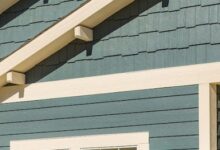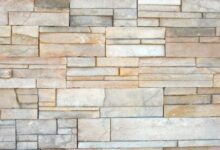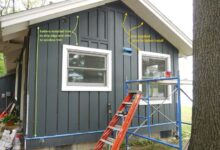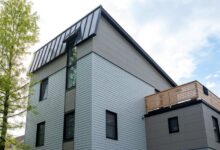Siding Repair Costs A Comprehensive Guide
Siding Repair Costs: Understanding the true expense of fixing your home’s exterior is crucial for budgeting and avoiding costly surprises. From minor cracks to extensive damage, the price tag can vary wildly depending on several key factors. This guide breaks down everything you need to know, from material types and labor costs to choosing the right contractor and preventing future repairs.
We’ll explore the nuances of different repair methods, the pros and cons of DIY versus professional work, and ultimately help you navigate the often-complex world of siding repair with confidence.
The cost of siding repair hinges on a multitude of variables. Material type significantly influences pricing, with vinyl generally being the most affordable, while wood and fiber cement command higher costs due to their complexity and durability. The extent of the damage—a small crack versus a large section needing replacement—also dramatically impacts the final bill. Labor costs, influenced by location and contractor experience, can add up quickly.
Finally, don’t forget about hidden expenses like permits, waste disposal, and potential underlying structural issues that may require attention.
Factors Influencing Siding Repair Costs
Repairing your home’s siding can be a significant investment, and understanding the factors that influence the final cost is crucial for budgeting and planning. Several key elements contribute to the overall expense, ranging from the type of siding material to the extent of damage and the location of your property. Let’s delve into the specifics to give you a clearer picture.
Siding Material Impact on Repair Costs
The type of siding significantly impacts repair costs. Vinyl siding, known for its affordability and ease of maintenance, generally requires less expensive repairs compared to more complex materials. Wood siding, while aesthetically pleasing, often demands higher repair costs due to its susceptibility to rot, insect damage, and the need for specialized craftsmanship. Fiber cement siding, a durable and long-lasting option, falls somewhere in between, with repair costs typically higher than vinyl but often lower than wood, depending on the extent of damage.
Metal siding, while durable, can be costly to repair due to the specialized tools and expertise needed. The cost difference is primarily driven by material prices, the complexity of installation and repair techniques, and the longevity of each material.
Extent of Damage and Repair Expenses
The extent of damage is another critical factor determining repair costs. Minor repairs, such as replacing a few damaged panels, will naturally be less expensive than extensive repairs or full siding replacement. Moderate damage, perhaps involving a larger section of damaged siding or some underlying structural issues, will increase the cost considerably. Severe damage, encompassing significant structural compromise or widespread deterioration, will result in the highest repair costs, potentially involving complete siding removal and replacement.
For example, a few cracked vinyl panels might cost a few hundred dollars to repair, while extensive water damage requiring structural repairs could reach several thousand.
Labor Costs: Geographic Location and Contractor Experience
Labor costs are a significant portion of any siding repair project. Geographic location plays a vital role, with labor rates varying considerably across different regions. Major metropolitan areas generally have higher labor costs than rural areas due to higher demand and living expenses. The contractor’s experience and reputation also influence labor costs. Highly experienced and reputable contractors command higher rates due to their expertise and the assurance of quality workmanship.
A less experienced contractor might offer lower rates, but the quality of work may be compromised, potentially leading to future problems and additional expenses. For instance, a simple repair job in a rural area might cost $500, whereas the same job in a major city could cost upwards of $1000 due to higher labor rates.
Additional Costs: Permits, Disposal, and Structural Repairs
Beyond material and labor costs, several additional expenses can significantly impact the total project cost. Permits are often required for siding repairs, especially for larger projects. Disposal fees for old siding materials also add to the overall expense. In cases where siding damage reveals underlying structural issues, further repairs become necessary, adding considerable cost. These unforeseen expenses can quickly inflate the project budget, making it essential to factor them into your initial planning.
For example, obtaining permits could cost between $100 and $500 depending on local regulations, while disposal fees can range from $100 to $300 depending on the volume of waste and local disposal policies.
Average Cost Per Square Foot for Siding Repair
| Siding Material | Minor Repair | Moderate Repair | Severe Repair (Replacement) |
|---|---|---|---|
| Vinyl | $2-$5 | $5-$15 | $8-$20 |
| Wood | $5-$10 | $15-$30 | $20-$40+ |
| Fiber Cement | $7-$12 | $15-$35 | $25-$45+ |
| Metal | $10-$15 | $25-$40 | $35-$60+ |
Note: These are average costs and can vary significantly based on location, contractor, and specific project details. Always obtain multiple quotes before committing to a project.
Types of Siding Repairs and Associated Costs
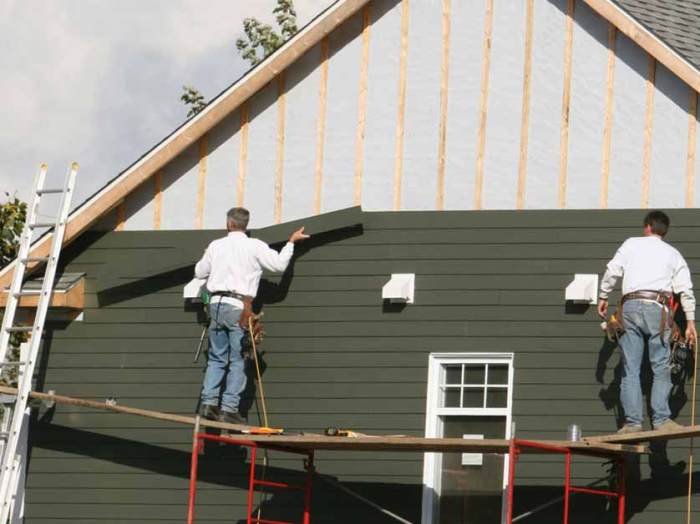
Siding repair costs can vary dramatically depending on the extent of the damage and the type of siding involved. Understanding the different types of repairs and their associated price points is crucial for homeowners planning a project. This knowledge empowers you to make informed decisions, budgeting effectively and avoiding unexpected expenses. Let’s delve into the specifics.
Patching vs. Section Replacement vs. Full Siding Replacement
Patching involves repairing small areas of damaged siding, typically costing significantly less than replacing larger sections or the entire siding system. A small crack or hole might be fixed for a few hundred dollars, encompassing materials and labor. Replacing a damaged section, however, involves removing and replacing a portion of the siding, potentially costing several hundred to a thousand dollars, depending on the size of the area and the type of siding.
Full siding replacement, on the other hand, is a major undertaking and can cost thousands, even tens of thousands of dollars, depending on the size of the house and the chosen siding material. For instance, replacing the siding on a small ranch-style home might cost between $5,000 and $15,000, while a large Victorian home could easily exceed $20,000.
Repair Costs Based on Damage Cause
The cause of the damage significantly influences repair costs. Weather-related damage, such as cracks from expansion and contraction, often requires less extensive repairs than damage caused by pests, which may necessitate more extensive treatment and repairs to the underlying structure. Impact damage, such as dents from hail or falling branches, can range from minor patching to full section replacement depending on the severity.
For example, a small hail dent might only require a simple filler and paint, while a large hole caused by a falling branch could require replacing several siding panels. Pest infestations, such as termite damage, often require not only siding repair but also treatment of the underlying wood, driving up the total cost.
Repair Methods for Common Siding Problems
Different repair methods exist for various siding issues. Cracks can often be repaired with caulking or patching compounds, a relatively inexpensive solution. Holes, depending on size, may require patching, replacement of individual planks, or even more extensive repairs. Water damage, a more serious issue, often necessitates more complex repairs, possibly including replacing damaged insulation and underlying sheathing, significantly increasing costs.
For instance, repairing water damage to a small area might cost a few hundred dollars, while extensive water damage requiring sheathing replacement could cost several thousand.
Typical Siding Repair Project Steps and Costs
Understanding the breakdown of costs for a typical siding repair project is essential for accurate budgeting.
- Assessment and Diagnosis: $50 – $200. A professional inspection to determine the extent of the damage and the best course of action. This includes identifying the cause of the damage and potential underlying issues.
- Material Procurement: $100 – $1000+. This varies greatly depending on the type and amount of siding, paint, caulk, and other materials needed.
- Preparation and Cleaning: $100 – $500. This includes cleaning the affected area and preparing the surface for repair.
- Repair Work: $200 – $5000+. This is the most variable cost, depending on the complexity of the repair, the size of the affected area, and the type of siding.
- Finishing and Cleanup: $50 – $200. This includes painting, caulking, and cleaning up the work area.
Remember that these are estimates, and actual costs can vary based on location, labor rates, and the specific nature of the repair. Always obtain multiple quotes from reputable contractors before starting your project.
Finding and Choosing a Siding Repair Contractor: Siding Repair Costs
Choosing the right contractor for your siding repair is crucial for a successful project and long-lasting results. A poorly chosen contractor can lead to shoddy workmanship, cost overruns, and even further damage to your property. Taking the time to thoroughly vet potential contractors will save you headaches and money in the long run.
Obtaining Multiple Quotes
Securing multiple quotes from different contractors is a cornerstone of responsible home improvement planning. This comparative approach allows you to assess not only the price but also the scope of work proposed by each contractor. Significant variations in quotes may indicate differences in the proposed materials, labor costs, or even the overall understanding of the repair needs. By comparing several detailed quotes, you can make an informed decision based on value and not just the lowest price.
For instance, a quote that seems significantly lower than others might indicate a compromise on quality materials or a lack of experience.
Evaluating Contractor Qualifications and Experience, Siding Repair Costs
Thorough evaluation of a contractor’s qualifications and experience is paramount. This involves verifying their licensing, insurance, and professional affiliations. Check their online reviews and testimonials from previous clients. Look for consistent positive feedback regarding professionalism, communication, and the quality of their work. Experience with similar siding types and repair projects is essential; a contractor experienced with vinyl siding might not be the best choice for repairing cedar shakes.
Consider contractors with a proven track record and a demonstrated commitment to customer satisfaction. For example, a contractor with 15 years of experience and a portfolio of successfully completed projects is likely a safer bet than a newly established business with limited experience.
Questions to Ask Potential Contractors
Before committing to a contractor, asking specific questions is essential. Inquire about their experience with your specific type of siding, their process for handling unforeseen issues, and their warranty policies. Understanding their project management approach, including timelines and communication protocols, is also crucial. Request references from past clients to verify their claims of quality workmanship and customer service.
Finally, inquire about their licensing and insurance coverage to ensure you are protected in case of accidents or disputes. For example, asking about their process for addressing potential mold issues during the repair process demonstrates your proactive approach and ensures they have a plan in place.
Reviewing a Contractor’s Contract
Before signing any contract, carefully review every detail. Ensure the contract clearly Artikels the scope of work, payment schedule, materials to be used, and the warranty provided. Clarify any ambiguous terms and confirm that all agreed-upon details are accurately reflected in the document. Look for clauses addressing potential delays, change orders, and dispute resolution mechanisms. A well-drafted contract protects both the homeowner and the contractor, preventing misunderstandings and potential conflicts.
For example, a clearly defined payment schedule that ties payments to specific milestones in the project protects you from paying in full before the work is completed to your satisfaction.
DIY Siding Repair vs. Hiring a Professional
Deciding whether to tackle siding repairs yourself or hire a professional is a crucial step in maintaining your home’s exterior. The choice hinges on a careful evaluation of your skills, available time, budget, and the complexity of the repair. While DIY offers potential cost savings, professional services ensure quality and longevity, minimizing the risk of further damage or costly mistakes.
Cost Comparison: DIY vs. Professional Siding Repair
The cost difference between DIY and professional siding repair can be substantial. DIY projects primarily involve the cost of materials, which can range from a few hundred dollars for minor repairs to potentially thousands for larger jobs. Factor in the cost of renting specialized tools if you don’t own them. Professional repair costs, however, vary greatly based on the extent of damage, type of siding, labor rates in your area, and the contractor’s experience.
A small repair might cost a few hundred dollars, while extensive damage could reach several thousand. For example, repairing a single damaged vinyl panel might cost $50-$100 in materials for a DIY approach, while a professional might charge $200-$400 including labor and disposal.
Tools and Materials for DIY Siding Repairs
Successfully completing a DIY siding repair requires the right tools and materials. For common repairs, such as patching small holes in vinyl siding, you’ll need items like a utility knife, measuring tape, caulk, matching vinyl siding patch (or a piece of scrap if you’re lucky enough to have some), sandpaper, and a putty knife. For more extensive repairs involving wood siding, you might need a hammer, nails, wood filler, paint, and a saw.
The cost of these materials can vary significantly depending on the type and quality you choose. A basic kit for minor vinyl repairs could cost around $30-$50, while a more comprehensive kit for wood siding repairs could cost upwards of $100.
Risks and Drawbacks of DIY Siding Repairs
Attempting DIY siding repairs without sufficient experience carries several risks. Improper repair techniques can lead to further damage, compromising your home’s weather resistance and potentially increasing future repair costs. For instance, incorrectly patching a hole in vinyl siding can allow water penetration, leading to rot and mold issues. Additionally, working at heights can be dangerous, and improper safety precautions could result in serious injury.
Finally, a poorly executed repair can impact your home’s curb appeal and decrease its value.
Example: Patching a Small Hole in Vinyl Siding
Repairing a small hole in vinyl siding is a relatively straightforward DIY project. First, carefully clean the area around the hole to remove any dirt or debris. Next, measure and cut a patch of matching vinyl siding, ensuring it’s slightly larger than the hole. Apply a bead of high-quality exterior-grade caulk around the edges of the patch. Gently press the patch into the hole, ensuring it’s flush with the surrounding siding.
Use a putty knife to smooth out any excess caulk. Finally, allow the caulk to fully cure before cleaning the area. Remember to always follow the manufacturer’s instructions for your specific type of siding and caulk. This simple repair, if done correctly, can extend the life of your siding and prevent further damage at a fraction of the cost of professional intervention.
Expand your understanding about Automated Blinds with the sources we offer.
Maintaining Siding to Prevent Costly Repairs
Proactive siding maintenance is the key to a long-lasting, attractive exterior and significantly reduces the likelihood of expensive repairs down the line. Ignoring minor issues can lead to escalating problems, resulting in far greater costs and potential structural damage. By implementing a regular maintenance schedule, homeowners can protect their investment and enjoy the beauty of their home for years to come.Regular cleaning and inspection are crucial for early detection of problems.
A proactive approach allows for timely intervention, preventing small issues from snowballing into costly repairs. Think of it like regular car maintenance; addressing a minor issue like a worn tire before it leads to a blowout saves you significant money and potential accidents. The same principle applies to your siding.
Siding Maintenance Tasks and Frequency
A well-defined maintenance schedule is essential for preserving your siding. This schedule should incorporate regular cleaning, inspection, and minor repairs as needed. Neglecting these tasks can lead to premature deterioration, necessitating costly replacements. For instance, a simple crack ignored can lead to water damage, mold growth, and eventually, the need for extensive repairs or even complete siding replacement.
- Annual Inspection: A thorough visual inspection should be conducted annually to check for cracks, gaps, loose panels, or signs of damage from pests or weather. This involves checking all sides of the house, paying close attention to areas prone to damage, such as corners, around windows and doors, and low-lying areas.
- Spring Cleaning: Use a soft-bristled brush and a gentle cleaning solution to remove dirt, grime, and cobwebs. Power washing should be done cautiously, avoiding excessive pressure that could damage the siding. For vinyl siding, a simple solution of mild detergent and water is usually sufficient. For other materials, consult manufacturer recommendations.
- Repair Minor Damage Promptly: Address small cracks, loose caulking, or minor damage immediately. A small tube of caulk and a putty knife can often resolve these issues before they become larger problems. Delaying these small repairs can lead to larger issues and greater costs later.
- Caulk Replacement Every Few Years: Caulk around windows, doors, and other areas where siding meets other building components degrades over time. Replacing it every 2-3 years prevents water intrusion and protects the underlying structure.
Visual Representation of a Properly Maintained Siding System
Imagine a house with clean, evenly-colored siding. There are no visible cracks, gaps, or loose panels. The caulking around windows and doors is intact and neatly applied. The gutters are clean and free of debris, ensuring proper water drainage away from the foundation. The paint (if applicable) is even and shows no signs of peeling or chipping.
The overall appearance is one of neatness and structural integrity. This visual represents a siding system that has received consistent and appropriate maintenance, showcasing its resilience and longevity. This is in stark contrast to a house with peeling paint, cracked siding, and overflowing gutters, which clearly shows a lack of maintenance. The difference is not just aesthetic; it’s a reflection of the financial savings resulting from preventative maintenance.
Concluding Remarks
Successfully tackling siding repair involves careful planning, informed decision-making, and a clear understanding of associated costs. By weighing the factors we’ve explored—material choice, damage extent, labor costs, and the DIY versus professional debate—you can make an educated choice that aligns with your budget and home’s needs. Remember, proactive maintenance is your best defense against expensive repairs down the line.
Regular cleaning, inspections, and prompt attention to minor issues can save you significant money and extend the lifespan of your siding for years to come. So, take control of your home’s exterior and safeguard your investment with a proactive approach to siding maintenance and repair.
